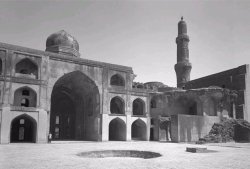Mahmud Gawan, a merchant by vocation, arrived in Bidar kingdom ruled by the Bahamani kings in 1453 A.D. He was well versed in Islamic lore, Persian language and mathematics. He was known for his profound scholarship in the Middle East before coming to India. Due to his perseverance, honesty, simplicity and learning he earned the goodwill of the Bahamani rulers and held important posts under three successive kings. Mahmud III (1462-82 A.D.) as a young boy studied under his tutorship, and became the grand Vazir or Prime Minister when Mahmud became the king and looked after the administration for nearly thirty years.
Gawan was rich due to his international trade but spent his entire earnings on promotion of education. In 1472 A.D. he established a Madrassah in Bidar, then the capital of the Bahmanis. The Madrassah had an imposing three-story building with 100 feet tall minarets in four corners. There were thrity-six rooms for students and six suites for the teaching staff. It also had big lecture halls, a prayer had and a matchless library of three thousand volumes. Gawan himself had a personal library of more than a thousand books. He used to spend all his leisure time in the library.
The Madrassah building had a large courtyard with nearly a thousand cubicles where students and learned men who came from all parts of the country and East could stay. Boarding and lodging were free. There were 118 students on a permanent basis and countless itinerary scholars.

The Madrassah of Mahmud Gawan, Bidar
Mahmud Gawan was familiar with renowned colleges at Samarkhand and Khorasan and his own college or Madrassah was modeled on the West Asian architecture.
Gawan tried to get renowned scholars from Persia and other West-Asian countries for teaching and heading the now famous college. But most of them declined the offer due to age and arduous journey. Sheikh Ibrahim Multani became head of the Madrassah and finally chief Kazi of the kingdom who is credited with spread of Islamic learning in the state.
Gawan’s growing clout in the court was a sour point with Dakhani or local Muslim leaders. They considered him a foreigner and his influence over the royalty brought in lot of contention. There were administrative reforms introduced by Gawan, which brought in much resentment among Dakhani governors. A careful plot was laid down by the courtiers to kill him. They obtained Gawan’s seal and affixed it on a blank paper and forged a letter inviting the king of Orissa to attack the Bahamani Kingdom. The letter was duly delivered to the king who was always in a drunken state. Without verifying the facts, the king sent for Gawan, and asked about the punishment to be meted out for treason. “Death” was the prompt reply given by Mahmud Gawan. The Sultan (king) showed him the letter. Although Gawan admitted that the seal was his, he pleaded complete innocence about the contents. But the Sultan was not in his senses and ordered Gawan’s beheading on the spot. Gawan warned the king to use discretion in such serious allegations. Those were his last words. Thus came the end of the scholar statesman.
When Gawan’s house was raided for alleged accumulated wealth, all that could be found was a mat, cooking vessels, the Holy Koran and 144 letters he wrote. Though the Madrassah suffered heavy loss due to his sudden death, the building continued in good condition for nearly two centuries. After the capture of Bidar by Aurangzeb in the late 17th century, the ranges of buildings were used for powder magazine and as barracks for a body of cavalry. Unfortunately lightening struck the powder magazine and there was a huge explosion, destroying the greater part of the edifice causing immense damage. Most of the rooms and three minarets were destroyed. Only one minaret and few cubicles have survived today. (see picture above)

No comments:
Post a Comment